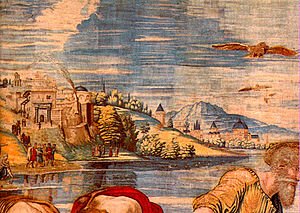Vates is a Latin word denoting seers, prophets, soothsayers, diviners and fortune tellers. According to the Ancient Greek writers Strabo, Diodorus Siculus and Poseidonius, the Vates (οὐάτεις) were one of three classes of Celtic priesthood, the other two being the Druids and the Bards. As previously discussed, the Vates performed sacrifices under the authority of a Druid.
The word Vate means “to inspire” or “spiritually arouse”. In pagan Rome the Vates resided on the Vatican Hill, the Hill of the Vates. The Vatican Hill takes its name from the Latin word Vaticanus, in reference to the Vates, who delivered their messages on the Vatican Hill.
The Germanic god Wōđinaz (Woden in old English and Odin to the Norse) may be an early loanword based on the Celtic Vates.
Celtic Witches
If you look up witches, the word only seems to go back to the Anglo Saxon words Wicca and Wicce and dates from the eleventh century. However, if you look at the Vates they were indeed ancient versions of witches. Modern Bible translations use the term “witch of Endor” who could communicate with the dead prophet Samuel. Egyptians certainly used magic and even the Bible states that they were able to copy some of the feats of Aaron’s mystical rod.
Witches are from the dawn of time. As long as there has been magick, there have been witches. They are attuned to the spirit world and accounts show that Vates went into a trance like state and could not remember their utterances after speaking them. This is similar to the Shamans.
Shamanism was first recognized by Western observers working among traditional herding societies in central and northern Asia, and it is from the language of one of these societies, the Tungus speaking peoples of Siberia, that the term “shaman” is derived.

However, because higher spirit beings can communicate with those who are gifted, shamans live wherever there are people. Some animals, such as wolves, dogs and cats also have a natural connection with spirit.
Sometimes staring at something we cannot see, these animals are observing spirit. All living beings are a container for spirit and when we die that spirit is released and for a time can be contacted through a natural or trained medium.
To be a Vate, you need to be gifted. Training will only bring out that divine gift which is present. Most of us, though, are gifted in some way, but a Vate is an expert with the gift. The gift is for sharing and that is why it has been bestowed. It presents evidence of the spiritual realm and their involvement in our lives.
It also explains why civilisations separated by thousands of miles, such as Native Americans, have similarities.
One of the gifts that can be shared and used, is the knowledge of herbs and healing. Once a secret of the Vates, this knowledge is now widely available.




Reblogged this on Vermont Folk Troth.
LikeLike
Allow me to air my ignorance. I read a book on druidry which spoke of an Order of Ovates, and suggested there were degrees alongside Druids and Bards which were all related. Is an Ovate an extension of your Vate? A separate thing? I liked your write-up, by the way. There’s an angle I hadn’t seen. I knew the ancient Teutons and Celts were more tightly linked, Teuton being related to Teutates, Taranis being related to Thor/Tyr, etc, among countless other parallels if not linguistic than thematic. Thanks, anyway. Wassail and all that then.
LikeLike
Ovate and Vate are the same. Some scholars regard Ovate as a mistranslation.
LikeLiked by 1 person